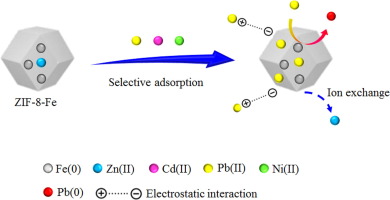当前位置:
X-MOL 学术
›
J. Colloid Interface Sci.
›
论文详情
Our official English website, www.x-mol.net, welcomes your feedback! (Note: you will need to create a separate account there.)
A new nFe@ZIF-8 for the removal of Pb(II) from wastewater by selective adsorption and reduction.
Journal of Colloid and Interface Science ( IF 9.9 ) Pub Date : 2020-01-08 , DOI: 10.1016/j.jcis.2020.01.014 Long Zhou 1 , Na Li 1 , Xiaoying Jin 1 , Gary Owens 2 , Zuliang Chen 1
Journal of Colloid and Interface Science ( IF 9.9 ) Pub Date : 2020-01-08 , DOI: 10.1016/j.jcis.2020.01.014 Long Zhou 1 , Na Li 1 , Xiaoying Jin 1 , Gary Owens 2 , Zuliang Chen 1
Affiliation

|
A nFe@ZIF-8 composite, which combined the tailorable porosity of ZIF-8 with the versatile functionality of Fe nanoparticles (nFe), was synthesized for Pb(II) removal. Batch adsorption experiments showed that more than 95.3% of Pb(II) was removed from aqueous solution at an initial concentration of 50 mg L-1 when using nFe@ZIF-8 within 60 min at pH value of 5. The mechanism of Pb(II) removal was studied via characterization of changes the morphology, size and composition of in nFe@ZIF-8 before and after exposure the solutions containing Pb(II). Specifically, Fourier transform infrared (FTIR) and X-ray powder diffraction (XRD) indicated that nFe@ZIF-8 was successfully synthesized and also remained stable after Pb(II) removal. Transmission Electron Microscope (TEM) and Scanning electron microscopy-X-ray energy dispersive spectrometer (SEM-EDS) both confirmed that Pb(II) was partially adhered onto the surface of nFe@ZIF-8, where X-ray photoelectron spectroscopy (XPS) specifically revealed the existence of Pb(0) on the surface. This indicated that Pb(II) was initially adsorbed onto the surface of nFe@ZIF-8 and subsequently reduced to Pb(0). Moreover, Pb(II) removal fit well to kinetics of absorption and reduction. Finally, in practice, nFe@ZIF-8 could remove 96.3% of Pb(II) from an electroplating wastewater.
中文翻译:

一种新的nFe @ ZIF-8,用于通过选择性吸附和还原去除废水中的Pb(II)。
合成了一种nFe @ ZIF-8复合材料,该复合材料将ZIF-8的可调节孔隙率与Fe纳米颗粒(nFe)的通用功能相结合,用于去除Pb(II)。批量吸附实验表明,当在60 pH值为5的条件下使用nFe @ ZIF-8在60分钟内以50 mg L-1的初始浓度从水溶液中去除了95.3%以上的Pb(II)。 II)通过表征暴露在含Pb(II)溶液之前和之后nFe @ ZIF-8中的形态,大小和组成的变化来研究去除。具体而言,傅立叶红外光谱(FTIR)和X射线粉末衍射(XRD)表明nFe @ ZIF-8已成功合成,并且在去除Pb(II)后仍保持稳定。透射电子显微镜(TEM)和扫描电子显微镜-X射线能量色散光谱仪(SEM-EDS)均证实Pb(II)部分粘附在nFe @ ZIF-8的表面上,在那里X射线光电子能谱(XPS) )特别揭示了表面上Pb(0)的存在。这表明Pb(II)最初被吸附到nFe @ ZIF-8的表面,随后被还原为Pb(0)。此外,去除Pb(II)非常适合吸收和还原动力学。最后,在实践中,nFe @ ZIF-8可以从电镀废水中去除96.3%的Pb(II)。这表明Pb(II)最初被吸附到nFe @ ZIF-8的表面,随后被还原为Pb(0)。此外,去除Pb(II)非常适合吸收和还原动力学。最后,在实践中,nFe @ ZIF-8可以从电镀废水中去除96.3%的Pb(II)。这表明Pb(II)最初被吸附到nFe @ ZIF-8的表面,随后被还原为Pb(0)。此外,去除Pb(II)非常适合吸收和还原动力学。最后,在实践中,nFe @ ZIF-8可以从电镀废水中去除96.3%的Pb(II)。
更新日期:2020-01-09
中文翻译:

一种新的nFe @ ZIF-8,用于通过选择性吸附和还原去除废水中的Pb(II)。
合成了一种nFe @ ZIF-8复合材料,该复合材料将ZIF-8的可调节孔隙率与Fe纳米颗粒(nFe)的通用功能相结合,用于去除Pb(II)。批量吸附实验表明,当在60 pH值为5的条件下使用nFe @ ZIF-8在60分钟内以50 mg L-1的初始浓度从水溶液中去除了95.3%以上的Pb(II)。 II)通过表征暴露在含Pb(II)溶液之前和之后nFe @ ZIF-8中的形态,大小和组成的变化来研究去除。具体而言,傅立叶红外光谱(FTIR)和X射线粉末衍射(XRD)表明nFe @ ZIF-8已成功合成,并且在去除Pb(II)后仍保持稳定。透射电子显微镜(TEM)和扫描电子显微镜-X射线能量色散光谱仪(SEM-EDS)均证实Pb(II)部分粘附在nFe @ ZIF-8的表面上,在那里X射线光电子能谱(XPS) )特别揭示了表面上Pb(0)的存在。这表明Pb(II)最初被吸附到nFe @ ZIF-8的表面,随后被还原为Pb(0)。此外,去除Pb(II)非常适合吸收和还原动力学。最后,在实践中,nFe @ ZIF-8可以从电镀废水中去除96.3%的Pb(II)。这表明Pb(II)最初被吸附到nFe @ ZIF-8的表面,随后被还原为Pb(0)。此外,去除Pb(II)非常适合吸收和还原动力学。最后,在实践中,nFe @ ZIF-8可以从电镀废水中去除96.3%的Pb(II)。这表明Pb(II)最初被吸附到nFe @ ZIF-8的表面,随后被还原为Pb(0)。此外,去除Pb(II)非常适合吸收和还原动力学。最后,在实践中,nFe @ ZIF-8可以从电镀废水中去除96.3%的Pb(II)。



























 京公网安备 11010802027423号
京公网安备 11010802027423号